Symbol Code: SM000013 Symbol Name: Dara Celtic Knot (Category: Celestial and Cosmic Beauty )
|
 | (Cosmic Destiny): Dara Celtic Knot The Celtics and especially, Druids considered the oak tree as sacred. They used to derive meaningful messages applicable in day-to-day life through the language of trees. Oak tree is the symbol of destiny, power, strength, wisdom, leadership and endurance. Roots of the oak tree represented in the form of Dara Celtic knot are symbolic of the great source of inner strength or divine resources we possess.
Reference: |
|
Symbol Code: SM000014 Symbol Name: The Cornucopia (Category: Celestial and Cosmic Beauty )
|
 | (Cosmic Food): The Cornucopia, or Horn of Plenty, is a Greek symbol of harvest abundance and prosperity. It consists of a horn – shaped basket filled with grains and fruits. According to Greek mythology, when Zeus was an infant, he was fed by a goat called Amalthea. Later, Zeus rewarded Amalthea by making her into a constellation (Capricorn), while she gave her horn to his nurses, telling them it would be an unending supply of everything they needed. This is why in Greek, the Horn of Plenty is called the Horn of Amalthea.
Reference: |
|
Symbol Code: SM000015 Symbol Name: The Om symbol (Category: Celestial and Cosmic Beauty )
|
 | (Cosmic Sound): The Om symbol is composed of three distinct sounds: a, u and m. It should be pointed out that the number three is important in Hinduism, since it teaches that there are three worlds (earth, heaven and the atmosphere), three major gods (Brahma, Vishnu and Siva), and three Vedic scriptures: Rg, Yajur and Sama. Because of this, it is believed that Om contains the essence of life and the universe. It is also said that sound (the sacred sound Om) was created before the universe.
Reference: |
|
Symbol Code: SM000016 Symbol Name: Sacred Geometry (Category: Celestial and Cosmic Beauty )
|
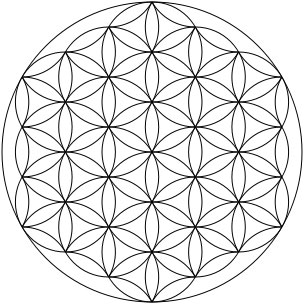 | (Cosmic Union): Although the symbol has its origins long before the Christian era, the early Christians used the symbol as a method to describe the coming together of heaven and earth, between the divine and human. Buddhists use the symbol as well.
Reference: |
|
Symbol Code: SM000111 Symbol Name: Kahanu (Category: Celestial and Cosmic Beauty )
|
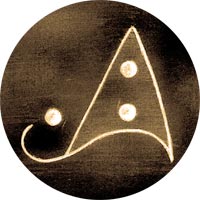 | (Cosmic Light): Meaning: "The wave of light that makes you gasp."Use: This symbol brings down the light in a wave by connecting the Kahuna to the source of all light, as a brilliant sun just above the top of the symbol. It is used to fill the body with light, opening up the circuitry. The symbol is generally used at the third eye or above. In meditation on this symbol, imagine the source of all light as a brilliant sun just above the top of the symbol. Now, bring the sun into your body along with the symbol. In this way, it is possible to fill the body with light.
Reference:http://www.ancienthuna.com/symbols_pics.htm |
|
Symbol Code: SM000236 Symbol Name: Sun Symbol (Category: Celestial and Cosmic Beauty )
|
 | The sun symbol is found in all cultures throughout history.Considered by most peoples as a cosmic power, it's not surprising we see the sun emblazed upon countless artifacts and writings.Ancient Chinese culture recognized the sun as the Great Male Principle – the ultimate Yang. These symbolically appreciative people also personified the sun as a cosmic eye viewing out upon its dominion during the day.
Reference:http://www.whats-your-sign.com/sun-symbol.html |
|
Symbol Code: SM000237 Symbol Name: Symbolic Moon (Category: Celestial and Cosmic Beauty )
|
 | This page on symbolic moon facts is devoted to the various illuminating qualities of the moon from a philosophical/metaphysical perspective.Throughout nature we find a cavalcade of energetic counterparts: Light/Dark, Male/Female, Increase/Decrease, etc., and the moon takes her place in the balance as the counter part to the sun.The sun is symbolic of the fraternal (male, yang) aspect of guidance; and so logically the moon stoically stands as the maternal (female or yin) influence.
Reference:http://www.whats-your-sign.com/symbolic-moon-facts.html |
|
Symbol Code: SM000238 Symbol Name: Mercury Symbol (Category: Celestial and Cosmic Beauty )
|
 | The Mercury symbol (shown above) can be a catalyst for our broader, symbolic view of this wholly engaging planet.I love the look of this symbol, and how it offers us a tell-tale story of Mercury's personality.To wit, we see the crescent opening upward, a gesture of receptivity. This physical attribute of the Mercury symbol certainly falls in-line with the symbolic personality of this planet, as Mercury is the planet of open-mindedness, new ideas and intelligence.
Reference:http://www.whats-your-sign.com/mercury-symbol.html |
|
Symbol Code: SM000239 Symbol Name: Venus Symbol (Category: Celestial and Cosmic Beauty )
|
 | The Venus symbol meaning is a combination of the circle and the cross.Visually this symbol speaks to us on two levels: Spiritual and Material.The circle reminds us of the inclusive nature of our universe. Here there is no exclusion. Only inclusion. All is welcome, and all is ever-expanding. Spirituality holds hands with this same inclusive concept. The mystic mind never pushes away, but always embraces what is. And, the at the base of all inclusion is the vibrating construct of love.
Reference:http://www.whats-your-sign.com/venus-symbol.html |
|
Symbol Code: SM000240 Symbol Name: Mars Symbol (Category: Celestial and Cosmic Beauty )
|
 | Exploring Mars SymbolismAlso known as the sign for "maleness" the Mars symbol embodies the yang principle (see quick-reference list below).Mars is a planet of dubious repute. It's often referred to as the "fiery planet" because of its red hue. It's also popularly known as a planet of war, and we see this in connection with Mars the Roman god (Ares in Greek myth) of war.
Reference:http://www.whats-your-sign.com/mars-symbol-and-symbolism.html |
|
Symbol Code: SM000241 Symbol Name: Jupiter Symbol (Category: Celestial and Cosmic Beauty )
|
 | The Jupiter symbol is comprised of several elements. The crescent with a horizontal line (looks like an Arabic "2") also known as the Greek letter zeta. This component suggests evolutionary development (maturity, and knowledge gained through a time of growth).The second component is the cross, which is symbolic of a meeting of ideas - a cross roads coming together to unite and combine two paths of philosophy. This plays nicely in Jupiter's symbolism of being a feature of balance.
Reference:http://www.whats-your-sign.com/jupiter-symbol-meanings.html |
|
Symbol Code: SM000242 Symbol Name: Saturn Symbol (Category: Celestial and Cosmic Beauty )
|
 | The Saturn symbol is composed of two design elements. The top cross, which is symbolic of the culmination of matter as well as the function of a intense focus. The second component of the Saturn icon is a crescent an element which it signifies receptivity.This lower "crescent" portion of the Saturn symbol is also reminiscent of a scythe or sickle. These are of particular interest because the symbolism of the planet Saturn (and the agricultural Roman god Saturn) often addresses themes of death. Note that in the archetype of death, this personification carries the sickle to acknowledge the opportune moment of harvesting current life.
Reference:http://www.whats-your-sign.com/saturn-symbol-meaning.html |
|
Symbol Code: SM000243 Symbol Name: Uranus Symbol (Category: Celestial and Cosmic Beauty )
|
 | The Uranus symbol is shown above, and here's another version:The Uranus symbol is based on several symbolic components, particularly the male symbol because of its association with the god by the same name in Greek myth.In ancient Greek myth, Uranus kicks off the beginning of life. In the Greek account of creation there was first a tremendous expanse of Chaos. From Chaos emerged two majestic manifestations in deific form: Gaea (Mother Terra) and Uranus (Father Sky).
Reference:http://www.whats-your-sign.com/uranus-symbol.html |
|
Symbol Code: SM000244 Symbol Name: Neptune Symbol (Category: Celestial and Cosmic Beauty )
|
 | The Neptune symbol is about the only thing straight-forward about the subject of Neptune. The cross at the lower end of the symbol is symbolic of matter, the root of things - the crux of nature. That cross is a stabilizer amongst the potentially erratic energies Neptune can represent.The three pronged pitchfork portion on top of the Neptune symbol represents a trident, commonly thought to represent Neptune, the god of the waters (Poseidon in Greek if you prefer).
Reference:http://www.whats-your-sign.com/neptune-symbol.html |
|
Symbol Code: SM000245 Symbol Name: Pluto Symbol (Category: Celestial and Cosmic Beauty )
|
 | The Pluto symbol is based on a combination of initials. The "P" represents Pluto the Roman god, and the "L" signifies Lowell, as in the Lowell Observatory who was the first to discover Pluto in the 1930s.As I'm writing this page on the Pluto symbol, god and planet meaning - science is in a heated debate about whether or not Pluto qualifies as a planet.Regardless, there are distinct qualities of this magnificent celestial body that bear acknowledging.
Reference:http://www.whats-your-sign.com/pluto-symbol.html |
|
Symbol Code: SM000246 Symbol Name: Starlight Symbolism and Metaphor (Category: Celestial and Cosmic Beauty )
|
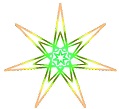 | Starlight symbolism also deals with navigation. For as long as humankind has been star-gazing, we've been using these glistening lights to mark our way through life. Whether using an astrolabe or casting an astrological star chart...stars are the ancient GPS for human observers.Starlight symbolism and metaphor encourages taking a hard look at that. There is a grand, powerful force that guides each of us. It could be the stars. It could be our passion. Maybe it's our idea of a higher power. Whatever it is...in order for it to move us in the right direction, it's got to be big and meaningful. Stars in terms of divine navigation remind us to make our motivational-maps big, beautiful, breathtaking and bold.
Reference:http://www.whats-your-sign.com/starlight-symbolism-and-metaphor.html |
|
Symbol Code: SM000247 Symbol Name: Joachim and Boaz (Mercy and Severity) (Category: Celestial and Cosmic Beauty )
|
 | (Cosmic Mercy): Jachim and Boaz are the pair of symbolic pillars (with Boaz on the left) described in the biblical account of the Temple of Solomon and featured prominently in Masonic temples.In the Jewish mystical kabbalah, Joachim and Boaz are the left and rightmost pillars of the tree of life- mercy and severity, or strength. Jachim represents the male polarity of the universe, light, motion, activity, the electron. Boaz represents the female polarity of the universe, darkness, passivity, receptivity, and silence. The pillars are similar in concept to the Eastern Yin Yang, representing opposites in balance.
Reference:http://symboldictionary.net/?s=mercy |
|
Symbol Code: SM000248 Symbol Name: The Pentagram in Freemasonry (Category: Celestial and Cosmic Beauty )
|
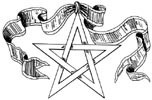 | (Cosmic Mercy): In Freemasonry and related traditions, the pentagram is usually referred to as the “blazing star,” and in addition to more traditional Pythagorean symbolism, is sometimes symbolic of the descent of the divinity of Christ into the world of matter, a remnant of Masonry’s ties with medieval Christian Kabbalah and hermetic tradition. In this, it represents the Star of Bethlehem. Freemasonry emphasizes Pythagorean geometry in its system of allegorical symbology, and as the pentagram was the chief of the Pythagorean symbols, it is not at all surprising to find it among Masonic symbols. Even so, it is still a relatively minor symbol in freemasonry, and largely ignored in today’s lodges.
Reference:http://symboldictionary.net/?s=mercy |
|
Symbol Code: SM000249 Symbol Name: The Pentacle and Magick (Category: Celestial and Cosmic Beauty )
|
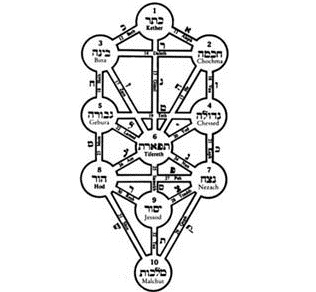 | (Cosmic Mercy): Renaissance-era ritual magicians, like the Greeks, used the Pentagram as a microcosm of the human body. The practice of Ritual Magic was used to create a state of closeness with god through the use of symbols and rituals to imitate the divine state. It was believed that like affects like, that the connection between the world of symbols and the world of actions could also be manipulated for evil purposes. One of these magicians, Giordano Bruno, warned of such misuse of the powerful pentacle by Black magicians. (The pentagram is still central to the practice of ritual magic, and is used in the foundation of many of its rituals.)In the Jewish kabbalistic tradition, which borrows many Pythagorean ideas, the pentagram represents the five upper sephiroth on the Tree of Life- five numbers, being indivisible by any but themselves, which represent pure archetypal forces: justice, mercy, wisdom, understanding, and transcendent splendor.
Reference:http://symboldictionary.net/?s=mercy |
|
Symbol Code: SM000250 Symbol Name: Curved Manji (Category: Celestial and Cosmic Beauty )
|
 | (Cosmic Mercy): The swastika used in Buddhist art and scripture is known as a Manji, and represents Dharma, universal harmony, and the balance of opposites. When facing left, it is the Omote (front) Manji, representing love and mercy. Facing right, it represents strength and intelligence, and is called the Ura (rear facing) Omoje. Balanced Manji are often found at the beginning and end of buddhist scriptures.
Reference:http://symboldictionary.net/?s=mercy |
|
Symbol Code: SM000251 Symbol Name: Unification Church (“Moonies”) (Category: Celestial and Cosmic Beauty )
|
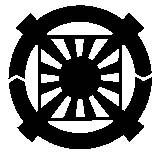 | (Cosmos): The symbol of the Unification Church of Sun Myung Moon (commonly referred to by the derogatory term “Moonies”), a group often accused of cult-like tendencies. According to church literature, the different parts of the symbol have various meanings:“The center circle symbolizes God, truth, life, and light. Those four elements reach out or radiate from this origin to the whole cosmos in twelve directions. The number twelve indicates the twelve types of human character. Historically, the number twelve has been important in God’s dispensation; for example, Jesus had twelve disciples. The significance of the symbol, then, indicates that truth (the Principle) is able to spread out in twelve ways. According to Father, the structure of the heavenly kingdom is also patterned after this basic system; i.e., twelve tribes and twelve character types. The outer circle represents the harmony of giving and receiving action, the principle of the cosmos.”The central wheel in this emblem is related to the kuruma, or carriage wheel, a traditional Japanese heraldic symbol.
Reference:http://symboldictionary.net/?s=cosmos |
|
Symbol Code: SM000252 Symbol Name: Omphalos (Category: Celestial and Cosmic Beauty )
|
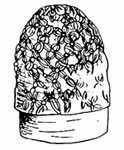 | (Cosmos): To the ancient Greeks, the Omphalos was a stone carved in the shape of a beehive, in this instance covered with a net-like pattern of chains, marking the birthplace of the Cosmos.Omphalos in Greek means “navel,” and may represent the plugging of the primordial waters of chaos.The most famous Omphalos was found at Delphi in Greece, representing the center of the cosmos. Similar objects have been found in temples in Rome, Iraq, Egypt, and Jerusalem.
Reference:http://symboldictionary.net/?s=cosmos |
|
Symbol Code: SM000253 Symbol Name: The Egg and the Serpent (Category: Celestial and Cosmic Beauty )
|
 | (Cosmos): The philosophical or cosmic egg is another nearly universal symbol. Alchemically, the egg is a symbol of the cosmos, as it is in a multitude of folk legends. In Hindu cosmology, it is the source of the universe. The egg as a container of the universe is found in many ancient religions. The egg symbolizes birth and potential. It contains within a miniature sun, and it features prominently in solar mythology. The gods Vishnu, Phanes, and Mithras, are all “egg born” solar deities. Another solar entity, the rooster, is also born of an egg.
Reference:http://symboldictionary.net/?s=cosmos |
|
Symbol Code: SM000412 Symbol Name: Hopi World Symbol (Category: Celestial and Cosmic Beauty )
|
 | (Hidden Cosmic Secrets): This symbol signifies world to the Hopi The "cosmic cross" or four bars represent north, south, east and west correspond to the outermost points on the horizon where the sun passes through the year; the solstice and equinox points. The four circles inside the outer outline represent the four nations (the first four tribes of mankind), which came to the world to keep balance.
Reference:http://www.whats-your-sign.com/Hopi-symbols.html |
|
Symbol Code: SM000413 Symbol Name: Hopi Kachina Sun Symbol (Category: Celestial and Cosmic Beauty )
|
 | (Hidden Cosmic Secrets): Also known as a Tawa kachina, it is a spirit symbolizing of life, growth, strength of spirit, and abundance. The likeness of this spirit is donned during the solstice ceremony to beckon the sun's return, and begin the growing season.
Reference:http://www.whats-your-sign.com/Hopi-symbols.html |
|
Symbol Code: SM000542 Symbol Name: Kneph (Winges kneph, Thelemic Hadit) (Category: Celestial and Cosmic Beauty )
|
 | (Cosmic Drama): A typical illustration of the Egyptian deity Kneph (soul-breath). Like the Greek pneuma, and the Hebrew Ruach, kneph represented the life-force. It was the breath of Kneph who brought both the gods and man to life.In Alchemy, the kneph variously represented the holy spirit, the state of volatility (mercury), or the creative force.In Freemasonry, the kneph was the cosmic egg, the state of potentiality.In Aleister Crowley’s Thelemic symbolism, the kneph represents Hadit, the “fire in the heart of matter,” the upward-rising force of kundalini.
Reference:http://symboldictionary.net/?p=3159 |
|
Symbol Code: SM000543 Symbol Name: Yin Yang (Yab Yam, Taiji) (Category: Celestial and Cosmic Beauty )
|
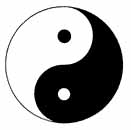 | (Cosmic Drama): The yin yang is the easily recognized Taoist symbol of the interplay of forces in the universe. In Chinese philosophy, yin and yang represent the two primal cosmic forces in the universe. Yin (moon) is the receptive, passive, cold female force. Yang (sun) is masculine-force, movement, heat. The Yin Yang symbol represents the idealized harmony of these forces; equilibrium in the universe. In ancient Taoist texts, white and black represent enlightenment and ignorance, respectively.
Reference:http://symboldictionary.net/?p=1725 |
|
Symbol Code: SM000588 Symbol Name: Right-turning Conch (Shankha) (Category: Celestial and Cosmic Beauty )
|
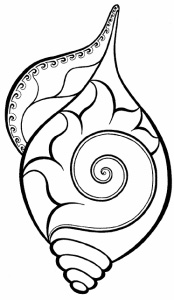 | (Cosmic Sound): The shankha or conch-shell is a traditional Vedic instrument. Like the shofar of Judaism, it is used originally as a war-horn, and later, as a ritual sounding-instrument. Its sound is believed to banish fear and evil spirits, and causes enemies to tremble. In Vedic belief, it is an attribute of Vishnu and a number of other deities.In Tibetan Buddhism, the conch is one of the eight Auspicious Symbols (Ashtamangala) representing the paths of Buddhism, and represents the voice of the Buddha and the truth of the dharma. Both Vedic and Buddhist tradition differentiates between shells whose spirals turn clockwise (in the direction of the sun) and counter-clockwise; the “right-turning” conch being more auspicious.
Reference:http://symboldictionary.net/?p=1750 |
|
Symbol Code: SM000805 Symbol Name: Swan (Category: Celestial and Cosmic Beauty )
|
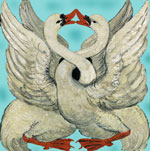 | (Celestail Wedding): The Swan holds a multitude of representations including love, grace, purity, beauty and sincerity. Another attribute of Aphrodite, the Swan also symbolized chastity. The Celts believed the Swans were benevolent dieties and legend has it that their images were forged into silver medallions worn around the neck for protection. In Hinduism, the Swan is known as the Hamsa bird and signifies the divine mind and the breath of spirit. The Swan is also another symbol of the Virgin Mary and the purity and love she symbolizes.
Reference:http://www.whats-your-sign.com/love-symbol-animal.html |
|
Symbol Code: SM000857 Symbol Name: Lietuvos Kryzius (Lithuanian Cross) (Category: Celestial and Cosmic Beauty )
|
 | (Cosmic and The Individual): The Lietvos Kryzius (“Lithuanian Cross”) is a stylized folk art cross commonly found in Lithuania, used for funerals and as votive offerings. The cross marries Lithuanian pagan and Christian symbolism, and is derived from pre-Christian renditions of the cosmic tree. Most images include solar and lunar symbolism, such as sun’s rays and crescent moons, as well as tree branches, etc.
Reference:http://symboldictionary.net/?p=858 |
|
Symbol Code: SM000858 Symbol Name: Yggdrasil (Norse Tree of Life) (Category: Celestial and Cosmic Beauty )
|
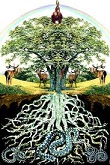 | (Cosmic and The Individual): A stylized image of Yggdrasil, the Norse World Ash, the giant mythological Tree that holds together the Nine Worlds or realms of existence. This image appears on the famous Överhogdal Tapestry, which dates to the year 1066 and depicts the events of Ragnarok, the apocalyptic prophecy of Pre-Christian Norse legend. The World-ash encompasses the Nine Worlds, and is guarded by the serpent Jormungandr. Yggdrasil is one of many variations of the Cosmic Axis or Universal World Tree known to all human cultures.Yggdrasil is home to many creatures, most notably the serpent or Dragon Nidhogg, who lurks in the base, The Rooster Gullinkambi (golden comb), who lives at the tree’s peak, and the squirrel, Ratatosk, who carries messages between them. These animals can be viewed as metaphors for the human body. According to Norse legend, Yggdrasil is where the god Odin hung upside-down for nine nights in order to obtain the Rune Alphabet. Beneath the roots of the World Ash lies the spring, Mimir, to which Odin sacrificed an eye to gain wisdom.
Reference:http://symboldictionary.net/?p=779 |
|
Symbol Code: SM000972 Symbol Name: Kneph (Winges kneph, Thelemic Hadit) (Category: Celestial and Cosmic Beauty )
|
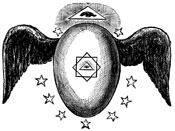 | (COSMIC COMBINATION): A typical illustration of the Egyptian deity Kneph (soul-breath). Like the Greek pneuma, and the Hebrew Ruach, kneph represented the life-force. It was the breath of Kneph who brought both the gods and man to life.In Alchemy, the kneph variously represented the holy spirit, the state of volatility (mercury), or the creative force.In Freemasonry, the kneph was the cosmic egg, the state of potentiality.In Aleister Crowley’s Thelemic symbolism, the kneph represents Hadit, the “fire in the heart of matter,” the upward-rising force of kundalini.
Reference:http://symboldictionary.net/?p=3159 |
|
Symbol Code: SM001021 Symbol Name: Right-turning Conch (Shankha) (Category: Celestial and Cosmic Beauty )
|
 | (COSMIC SOUND): The shankha or conch-shell is a traditional Vedic instrument. Like the shofar of Judaism, it is used originally as a war-horn, and later, as a ritual sounding-instrument. Its sound is believed to banish fear and evil spirits, and causes enemies to tremble. In Vedic belief, it is an attribute of Vishnu and a number of other deities.In Tibetan Buddhism, the conch is one of the eight Auspicious Symbols (Ashtamangala) representing the paths of Buddhism, and represents the voice of the Buddha and the truth of the dharma. Both Vedic and Buddhist tradition differentiates between shells whose spirals turn clockwise (in the direction of the sun) and counter-clockwise; the “right-turning” conch being more auspicious.
Reference:http://symboldictionary.net/?p=1750 |
|